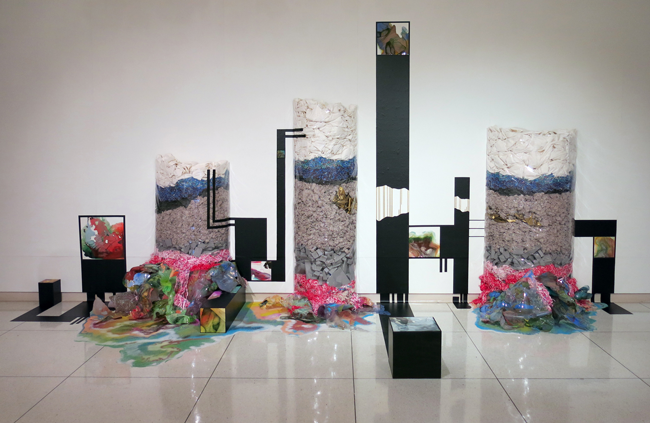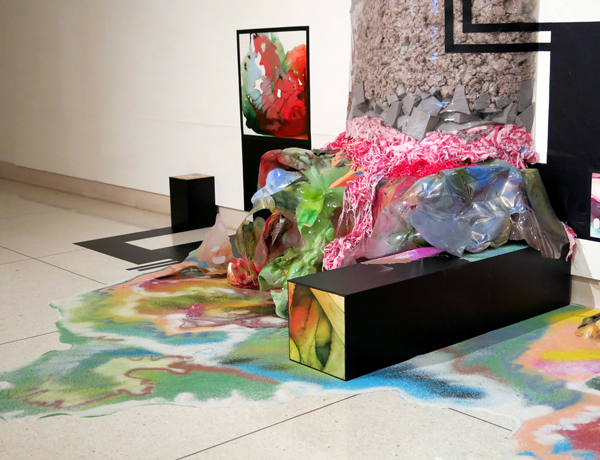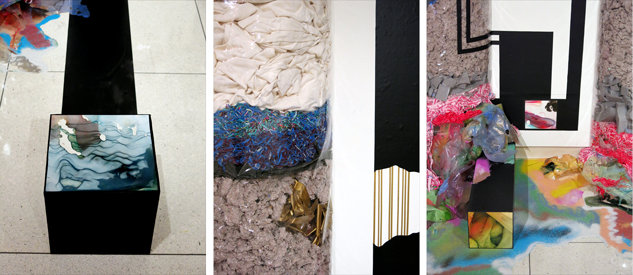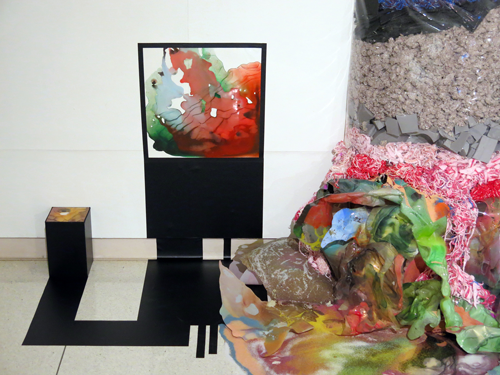Susan Murrell
All images by and courtesy of the artist.

The Advance, 2015, 9x18x6 feet, watercolor, acetate, sand, vinyl, tape, fabric remnants, insulation, gallery pedestals.
Technology has fundamentally changed our connection to the landscape. The horizon has defined our relationship to the world; now with our expanding perspective, we feel a kinship with microscopic images and areal views of planets. Vestiges of built environments, architecture, tools, or actions such as fracking and mining, may long outlive our existence. They are reflections of thought, something that begins from abstract philosophy, which morphs into a particular approach to life until it takes physical form.

The Advance (angle – little alter and core spill detail), 2015, watercolor, acetate, sand, vinyl, tape, fabric remnants, insulation, gallery pedestals.

The Advance (from left to right: altar detail; gold detail; between core, spill detail), 2015, watercolor, acetate, sand, vinyl, gallery pedestals, tape, fabric remnants, insulation.
I use nature-based spontaneous marks and black lines of quantitative illustration to interact with architecture and explore the organization of physical and intellectual space. Residual pigments left from the process of evaporation become a metaphor for the stuff of life and the natural world. Tape and vinyl create the clean lines of grids, maps, and charts which have become a shorthand for quantifying and designating ownership of new information. The gallery walls and paintings, like geological, biological, and cultural forces, simultaneously disintegrate and procreate, organizing themselves into complex systems through an emergent process.

The Advance (little alter and core spill detail) 2015, watercolor, acetate, sand, vinyl, tape, fabric remnants, insulation, gallery pedestals.
This mixed-media approach is part of a dialogue which expands the definition of painting. My work explores this shift in visual knowledge.

(upper left) The Advance (little alter and core spill detail) 2015, watercolor, acetate, sand, vinyl, tape, fabric remnants, insulation, gallery pedestals.
(upper right) Embedded Pipes, 2014, 5×5 feet, watercolor, flashe, acrylic, graphite on polymer paper.
(bottom left) Embedded Tracks, 2014, 5×5 feet, watercolor, flashe, acrylic, graphite on polymer paper.
(bottom right) Embedded Bot, 2014, 5×5 feet, watercolor, flashe, acrylic, graphite on polymer paper.
Susan Murrell is an artist living in La Grande, Oregon. Her large-scale and site-specific installations, paintings, and works on paper are exhibited nationally. She has been awarded residencies at international programs including Yaddo and Ragdale and in 2012 was a recipient of the Golden Spot Award at Crow’s Shadow Institute for the Arts. Recent solo-exhibitions include, “Embedded” at the Pendleton Center for the Arts, Oregon, “The Matter” at the International Gallery of Art in Anchorage, Alaska, “Areal Density” at the Portland International Airport, “Shell” at Whitman College in Walla Walla, Washington, “Substance and Circumstance” at Clark College in Vancouver, Washington, and “Subduction” at the Portland Building installation space. She earned a MFA in painting from Savannah College of Art and Design and is currently an Associate Professor of Art at Eastern Oregon University where she teaches painting and printmaking.